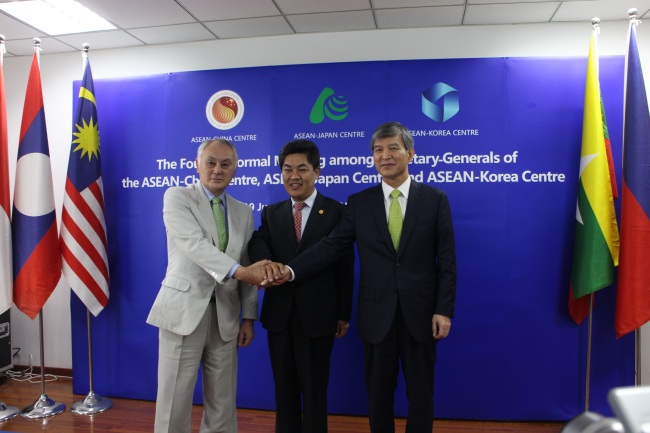Korea, China, Japan build bridges
Secretaries-general of Korean, Chinese and Japanese ASEAN centers hold Beijing confab
By Korea HeraldPublished : June 29, 2014 - 21:03
South Korea has a bridge-making role to play in enhancing cooperation between Japan and China, as well as in regional community building in East Asia in general, said the chief of the ASEAN-Korea Centre on Tuesday.
Secretary-General Chung Hae-moon made the comments after returning from a two-day meeting in Beijing with his ASEAN Centre counterparts in Japan and China.
Secretary-General Chung Hae-moon made the comments after returning from a two-day meeting in Beijing with his ASEAN Centre counterparts in Japan and China.

“Korea is ideally positioned in such a role because Japan and China feel comfortable with Korea being in that position,” Chung said in an interview with The Korea Herald on Tuesday.
The three secretaries general of the Association of Southeast Asian Nations centers in Korea, China and Japan met in Beijing from June 19-20 to discuss ways to strengthen cooperation among the ASEAN Plus Three countries.
Chinese Secretary-General Ma Ming-qiang hosted the trilateral meeting with his counterparts Onishi Yoshikuni of the ASEAN-Japan Centre and the ASEAN-Korea Centre’s Chung.
“The ASEAN Korea Centre can do such a bridge-building job because we believe we are in a position to bringing the three centers closer together,” Chung said. “Whenever you talk about regional cooperation, whether it is in Northeast Asia or in East Asia broadly, Korea has been playing a bridge-making role in the past, and Korea can continue to do that.”
The meeting marked the fourth such trilateral confab between the ASEAN centers of Japan, China and Korea.
The three had previously met at the 32nd ASEAN Tourism Forum in Laos in January 2013, in Seoul in April 2013 and on the sidelines of the 33rd ASEAN Tourism Forum in Malaysia earlier this year.
The first meeting took place at Chung’s initiative on the sidelines of the 12th ASEAN Tourism Forum.
The three representatives discussed cooperative activities, exchanges of personnel, and sharing best practices and other information among the three countries.
“We also talked about common projects, such as human resources development in Southeast Asian tourism, as well as the personnel exchange programs at our centers,” said Chung.
The chiefs of the three centers meet annually on the sidelines of the ASEAN tourism forum, and once more in an exclusive meeting.
Chung said he would like to meet his Japanese and Chinese counterparts twice a year in order “to maintain momentum on the many joint projects that the centers could cooperate on.”
Chung said that the centers also plan joint publications on the three centers’ relations with the Southeast Asian association. “It would be very helpful to entrepreneurs deliberating business decisions for us to publish figures and trends that illustrate the respective trade and commercial ties between Japan, South Korea and China and ASEAN.”
“It is not good enough for the booklets we publish to only describe the economic interactions between South Korea and ASEAN. It would give a fuller picture if the publications include those interactions between China and ASEAN and Japan and ASEAN,” he said.
The secretaries general also discussed the joint participation of the centers in important ASEAN Plus One and ASEAN Plus Three meetings, and intensifying engagement with other ASEAN secretariats.
“In fact we have a dual role to play. One is to strengthen the relations between our respective countries and ASEAN. Another role is to improve the cooperation among our three centers and ASEAN,” he said.
The two major East Asian community-building mechanisms are ASEAN Plus Three and the East Asian Summit process. “The ASEAN Plus Three process I think has achieved a lot in terms of economic and financial cooperation among the 13 participating countries,” said Chung, a career diplomat who has served as head of the ASEAN Plus Three Centre since March 2012. “Our ASEAN centers can contribute even more to the ASEAN+3 process by increasing the level of effective cooperation.”
The East Asia Summit process started in 2005 as a strategic forum for leaders to discuss political and strategic issues as well as other issues with global implications. ASEAN Plus Three came into being as a result of the financial crisis that hit the region in 1997.
The three ASEAN centers were established to promote trade, investment, tourism, cultural exchanges and education between ASEAN and the “plus three” countries ― Korea, China and Japan.
The secretaries general acknowledged the important role the three centers play in strengthening cooperation among ASEAN and China, Japan and Korea, referring to an official statement issued in Phnom Penh, Cambodia, on Nov. 19, 2012: the “ASEAN Plus Three Leaders’ Joint Statement on the Commemoration of the 15th Anniversary of the ASEAN Plus Three Cooperation.”
It is hoped that the cooperation among the three ASEAN centers will contribute to enhancing the ASEAN Plus Three’s people-to-people connectivity, and drive a movement toward deeper integration of the ASEAN Plus Three region, the ASEAN-Korea Centre said.
The ASEAN-Korea Centre was established as an intergovernmental organization in March 2009. Its mandate is to increase trade volume, accelerate investment flow, invigorate tourism and enrich cultural exchanges between Southeast Asia and Korea.
By Philip Iglauer (ephilip2014@heraldcorp.com)
-
Articles by Korea Herald




![[Herald Interview] 'Amid aging population, Korea to invite more young professionals from overseas'](http://res.heraldm.com/phpwas/restmb_idxmake.php?idx=644&simg=/content/image/2024/04/24/20240424050844_0.jpg&u=20240424200058)












![[KH Explains] Korean shipbuilding stocks rally: Real growth or bubble?](http://res.heraldm.com/phpwas/restmb_idxmake.php?idx=652&simg=/content/image/2024/04/25/20240425050656_0.jpg&u=)

